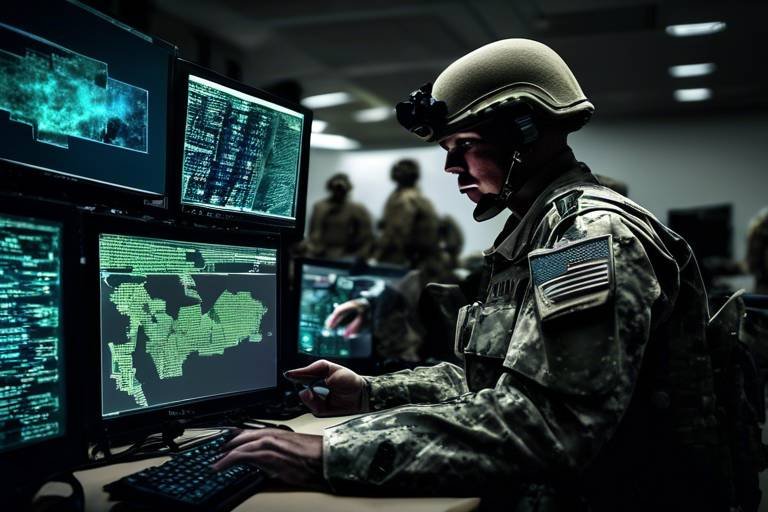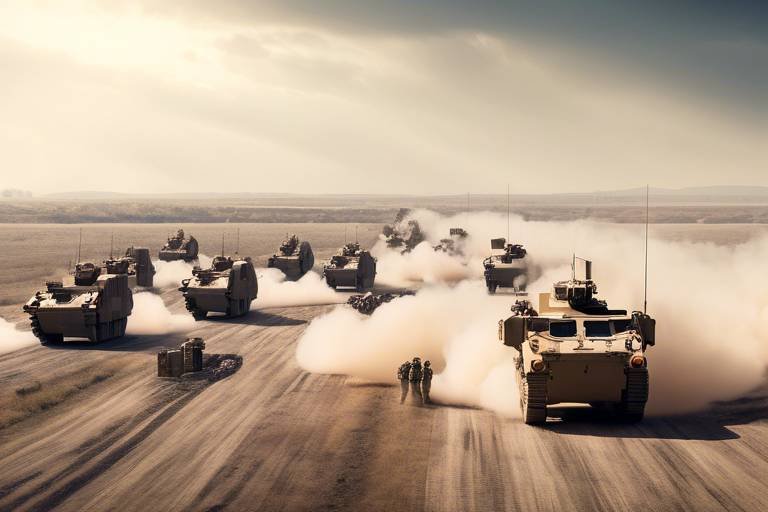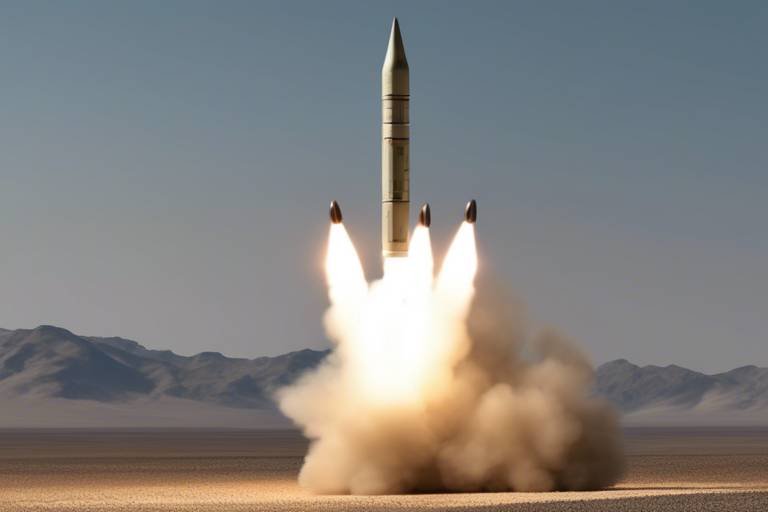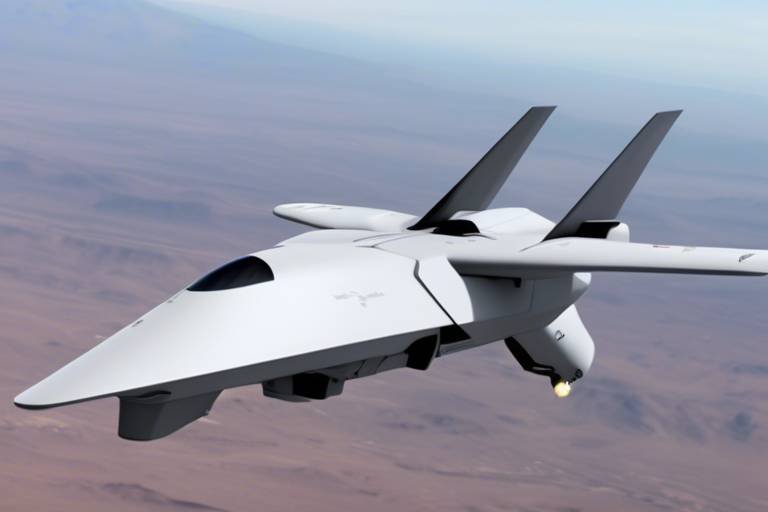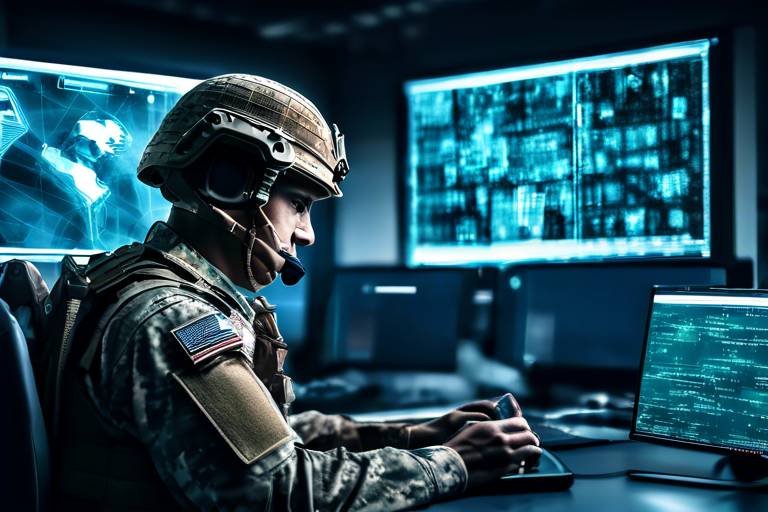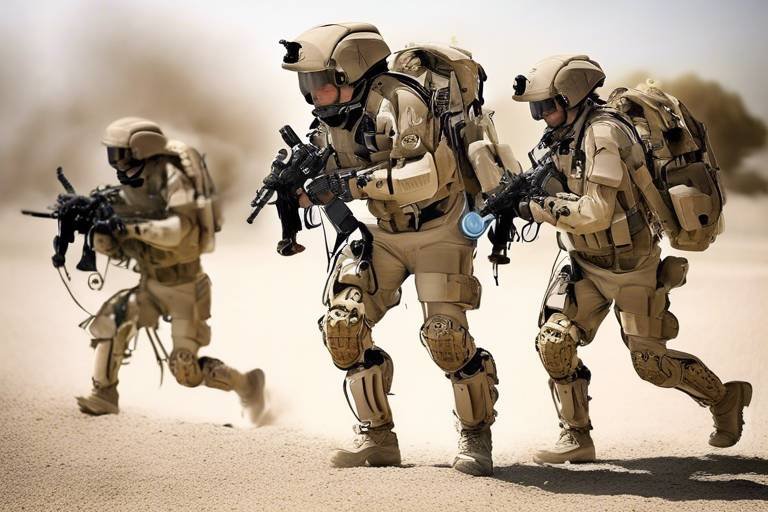How Cybersecurity is Evolving in Military Operations
Cybersecurity has become a cornerstone of modern military operations, evolving rapidly to meet the challenges posed by an increasingly digital battlefield. With the rise of technology, military forces around the globe are not just focusing on traditional warfare but are also prioritizing the protection of their digital assets. Imagine a world where a single cyber attack could cripple an entire military operation—this is the reality today. As adversaries develop more sophisticated tactics, the need for robust cybersecurity measures has never been more critical.
In this landscape, military operations face a myriad of challenges. From securing sensitive information to ensuring the integrity of communication systems, the stakes are higher than ever. The importance of cybersecurity in military operations can’t be overstated; it’s not just about protecting data but also about maintaining national security. The military must stay one step ahead of cybercriminals and state-sponsored hackers who are constantly innovating their strategies. This dynamic environment demands a proactive approach to cybersecurity, integrating advanced technologies and strategies that can adapt to the evolving threat landscape.
Furthermore, as we delve deeper into this topic, we’ll explore how the military is leveraging emerging technologies like artificial intelligence (AI) and machine learning (ML) to enhance their cyber defense capabilities. These technologies are not just buzzwords; they are game changers that allow for quicker detection and response to cyber threats, making military operations more resilient than ever. But it doesn't stop there. Training and awareness programs are vital for military personnel to understand the risks associated with cyber threats and adopt best practices in their daily operations.
In the realm of cybersecurity, collaboration is key. The military is increasingly working with the private sector to tap into innovative cybersecurity solutions and share threat intelligence. This partnership not only strengthens defense capabilities but also fosters a culture of security that permeates through all levels of military operations. As we look to the future, it’s clear that military cybersecurity will continue to evolve, driven by advancements in technology, policy development, and international cooperation.
Understanding the critical role of cybersecurity in military operations is essential for protecting sensitive information and maintaining national security against evolving cyber threats. In an age where data is the new gold, safeguarding military communications, operational plans, and classified information is paramount. Cybersecurity isn’t just a technical issue; it’s a strategic imperative that influences every aspect of military readiness.
An overview of the current cyber threat landscape reveals the various actors, techniques, and vulnerabilities that military operations face, emphasizing the need for robust cybersecurity measures. The military must contend with a diverse array of threats, from individual hackers to organized cybercriminal groups and state-sponsored actors. Each of these entities employs unique tactics and methods to exploit vulnerabilities, making it crucial for military leaders to stay informed about the latest trends and threats.
State-sponsored cyber attacks have become increasingly sophisticated, targeting military infrastructure and sensitive data, which necessitates a proactive approach to cybersecurity in defense strategies. These attacks often involve advanced persistent threats (APTs) that can infiltrate military networks undetected, gathering intelligence or causing disruption. With the stakes so high, military organizations must invest in advanced cybersecurity solutions that can detect and neutralize these threats before they escalate.
Examining notable incidents of state-sponsored cyber attacks provides insight into the tactics used and the implications for military operations and national security. For example, the infamous Stuxnet worm demonstrated how a cyber weapon could be used to sabotage critical infrastructure, setting a precedent for future cyber warfare. Understanding these incidents helps military strategists develop more effective defenses against similar attacks.
Implementing preventive measures against state-sponsored attacks is crucial for enhancing military cybersecurity resilience and safeguarding critical assets. This includes regular vulnerability assessments, penetration testing, and the adoption of a zero-trust security model, which assumes that threats could be inside or outside the network. By fostering a proactive security culture, military organizations can better prepare for potential cyber threats.
Emerging technologies such as artificial intelligence and machine learning are transforming military cybersecurity strategies, enabling quicker detection and response to cyber threats. These technologies analyze vast amounts of data in real-time, identifying anomalies and potential threats faster than any human could. Imagine having a digital watchdog that never sleeps, tirelessly monitoring for signs of intrusion—that’s the power of AI in military cybersecurity.
Training and awareness programs are vital for military personnel to understand cybersecurity risks and best practices, ensuring a culture of security throughout the organization. Regular training sessions and workshops help personnel stay informed about the latest threats and defensive techniques, fostering a sense of responsibility and vigilance.
Conducting simulation and drills helps military personnel practice responses to cyber incidents, enhancing readiness and effectiveness in real-world scenarios. These exercises mimic potential cyber attacks, allowing teams to refine their response strategies and improve coordination among various units. It’s like a fire drill for the digital age—preparing for the worst so you can respond effectively when it matters most.
Collaboration with the private sector allows the military to leverage innovative cybersecurity solutions and share threat intelligence, strengthening overall defense capabilities. By partnering with cybersecurity firms, the military can access cutting-edge technologies and expertise that may not be available in-house. This collaboration creates a synergistic effect, enhancing the military's ability to combat cyber threats.
The future of military cybersecurity will likely involve advancements in technology, policy development, and international cooperation to address the continuously evolving cyber threat landscape. As cyber threats become more sophisticated, military strategies must also adapt, focusing on resilience, rapid response, and the integration of new technologies to stay ahead of adversaries.
- What is the role of AI in military cybersecurity? AI helps detect and respond to cyber threats more efficiently by analyzing data patterns and identifying anomalies.
- How can military personnel stay updated on cybersecurity threats? Regular training sessions, workshops, and simulations are essential for keeping military personnel informed about the latest cyber threats.
- Why is collaboration with the private sector important? Collaborating with private cybersecurity firms allows the military to access innovative solutions and share critical threat intelligence.
- What are state-sponsored cyber attacks? These are cyber attacks orchestrated by government entities aimed at disrupting or gathering intelligence from other nations' military operations.

The Importance of Cybersecurity in Military Operations
In today's digital age, the significance of cybersecurity in military operations cannot be overstated. With the increasing reliance on technology for communication, data storage, and operational planning, military organizations are more vulnerable than ever to cyber threats. Imagine a battlefield where the enemy can intercept communications or manipulate critical systems—this is not just a scene from a sci-fi movie; it's a reality that modern militaries must confront. Protecting sensitive information and maintaining national security are paramount, and effective cybersecurity measures are the first line of defense.
As military operations become more interconnected, the potential for cyber attacks grows exponentially. Cybersecurity is not merely a technical issue; it is a vital component of strategic planning. The military must ensure that its networks are secure and resilient against a variety of threats, including those posed by state-sponsored actors and rogue hackers. The implications of a successful cyber attack can be catastrophic, leading to compromised missions, loss of life, and a significant blow to national security.
Furthermore, the importance of cybersecurity extends beyond just protecting classified information. It encompasses the safeguarding of critical infrastructure, logistics, and operational capabilities. For instance, if an adversary were to disrupt supply chain systems or communication networks, it could severely hinder military readiness and response times. Thus, a comprehensive approach to cybersecurity is essential, integrating technology, policy, and personnel training.
To illustrate the multifaceted nature of military cybersecurity, consider the following key areas of focus:
- Data Protection: Ensuring that sensitive data is encrypted and accessible only to authorized personnel.
- Network Security: Implementing firewalls, intrusion detection systems, and regular security audits to protect military networks.
- Incident Response: Developing robust incident response plans to quickly address and mitigate the effects of cyber attacks.
Ultimately, the military must foster a culture of cybersecurity awareness among its personnel. This means not only training individuals on best practices but also instilling a sense of responsibility regarding the protection of information and systems. Cybersecurity is a team effort; every individual plays a role in maintaining the integrity and security of military operations.
As we move forward, the evolution of cyber threats will continue to challenge military operations. Therefore, understanding the importance of cybersecurity is not just about keeping up with technology but about ensuring that our national security remains intact in an increasingly hostile digital landscape.
- Why is cybersecurity critical for military operations? Cybersecurity is essential for protecting sensitive information, maintaining operational integrity, and ensuring national security against evolving cyber threats.
- What are the main threats to military cybersecurity? The main threats include state-sponsored cyber attacks, rogue hackers, and vulnerabilities in interconnected systems.
- How can military personnel improve cybersecurity awareness? Through training programs, simulations, and a culture that prioritizes security, personnel can better understand and mitigate cyber risks.

Current Cyber Threat Landscape
The is a complex arena where various actors, techniques, and vulnerabilities converge, constantly reshaping the way military operations approach cybersecurity. As technology evolves, so too do the methods employed by cybercriminals and state-sponsored actors. This dynamic environment creates a pressing need for robust cybersecurity measures that can adapt to the changing tides of threats. Military operations are not just battling traditional warfare; they are now engaged in a cyber war that can have devastating consequences if not addressed.
One of the most alarming aspects of this landscape is the rise of state-sponsored cyber attacks. These attacks are often sophisticated and well-funded, targeting military infrastructure, sensitive data, and critical communication systems. The implications of such attacks are profound, as they can disrupt operations, compromise national security, and erode public trust. The tactics used by these state actors can range from phishing and malware deployment to more advanced techniques like zero-day exploits, making it essential for military organizations to stay vigilant and proactive.
In addition to state-sponsored threats, there are also numerous non-state actors who pose significant risks. Cybercriminals, hacktivists, and even rogue individuals can exploit vulnerabilities in military networks for personal gain or ideological purposes. Understanding the motivations behind these attacks is crucial for developing effective defense strategies. For instance, while some may seek financial gain, others might aim to make a political statement or disrupt operations for ideological reasons. This diverse array of motivations adds another layer of complexity to the cybersecurity landscape.
Furthermore, as military operations increasingly rely on connected technologies, the attack surface expands exponentially. The integration of the Internet of Things (IoT), artificial intelligence (AI), and cloud computing into military operations presents new vulnerabilities that adversaries are eager to exploit. For example, a compromised IoT device could serve as an entry point for a larger attack on military networks, leading to potentially catastrophic consequences.
To illustrate the current threat landscape, consider the following table that summarizes the key actors and their motivations:
| Actor Type | Examples | Motivation |
|---|---|---|
| State-Sponsored | Nation-state actors | Political gain, espionage |
| Cybercriminals | Hackers, organized crime | Financial gain |
| Hacktivists | Political activists | Ideological reasons |
| Insider Threats | Disgruntled employees | Personal grievances |
With the stakes higher than ever, it’s crucial for military organizations to not only recognize these threats but also to develop comprehensive strategies that encompass prevention, detection, and response. The evolving nature of cyber threats requires a multi-faceted approach, combining technology, training, and collaboration across sectors. By fostering a culture of cybersecurity awareness and preparedness, military operations can bolster their defenses against this ever-changing landscape.
- What are state-sponsored cyber attacks? State-sponsored cyber attacks are cyber operations conducted by government-affiliated groups aimed at disrupting, damaging, or stealing information from other nations.
- How do non-state actors impact military cybersecurity? Non-state actors, including hackers and activists, can exploit vulnerabilities for personal or political motives, posing significant risks to military operations.
- What role does technology play in military cybersecurity? Technology enhances military cybersecurity by providing tools for detection, response, and prevention of cyber threats, but it also introduces new vulnerabilities that must be managed.

State-Sponsored Cyber Attacks
In today's digital battlefield, have emerged as a formidable threat, targeting military infrastructure and sensitive data with alarming frequency. These attacks are not just random acts of cyber vandalism; they are meticulously planned operations orchestrated by nation-states aiming to gain strategic advantages over their adversaries. Imagine a chess game where one player is not only trying to outmaneuver the other but is also trying to disrupt their entire strategy from the inside. That's the essence of state-sponsored cyber warfare.
The sophistication of these attacks is staggering. They often employ advanced techniques such as phishing, malware deployment, and zero-day exploits to infiltrate military systems. For instance, a state-sponsored group might use spear-phishing emails to trick military personnel into revealing their credentials, thereby gaining access to classified information. The implications of such breaches can be catastrophic, leading to the compromise of operational security and the potential loss of lives.
To illustrate the gravity of the situation, let's take a look at some notable incidents that highlight the tactics employed by these cyber adversaries:
| Incident | Year | Description |
|---|---|---|
| Stuxnet | 2010 | A sophisticated worm that targeted Iran's nuclear facilities, attributed to U.S. and Israeli forces. |
| Operation Aurora | 2009 | A series of cyber attacks against multiple companies, believed to be initiated by Chinese state-sponsored hackers. |
| SolarWinds | 2020 | A massive supply chain attack affecting numerous U.S. government agencies, linked to Russian cyber operatives. |
These incidents serve as a wake-up call for military organizations around the globe. They underscore the fact that cybersecurity is no longer just an IT issue; it has become a critical component of national defense strategy. The military must adapt its cybersecurity measures to counter these evolving threats effectively. This means not only investing in advanced technologies but also fostering a culture of vigilance and preparedness among personnel.
Preventive measures are essential in this fight against state-sponsored cyber attacks. This includes implementing robust security protocols, conducting regular vulnerability assessments, and ensuring that all personnel are trained to recognize and respond to potential threats. By taking a proactive stance, military organizations can enhance their resilience and safeguard their critical assets from these malicious actors.
In conclusion, as state-sponsored cyber attacks continue to evolve, so too must our strategies for defense. The stakes are high, and the consequences of inaction can be dire. It's crucial for military operations to stay one step ahead, leveraging technology and training to fortify their cyber defenses and protect national security.
- What are state-sponsored cyber attacks? State-sponsored cyber attacks are malicious actions taken by nation-states to infiltrate, disrupt, or damage the systems of other countries, often targeting military or critical infrastructure.
- How can military organizations protect themselves from these attacks? Military organizations can protect themselves by implementing strong cybersecurity measures, conducting regular training for personnel, and collaborating with cybersecurity experts in the private sector.
- What role does technology play in countering state-sponsored cyber threats? Technology plays a crucial role in detecting and responding to cyber threats quickly, with advancements in artificial intelligence and machine learning enabling more effective monitoring and defense strategies.
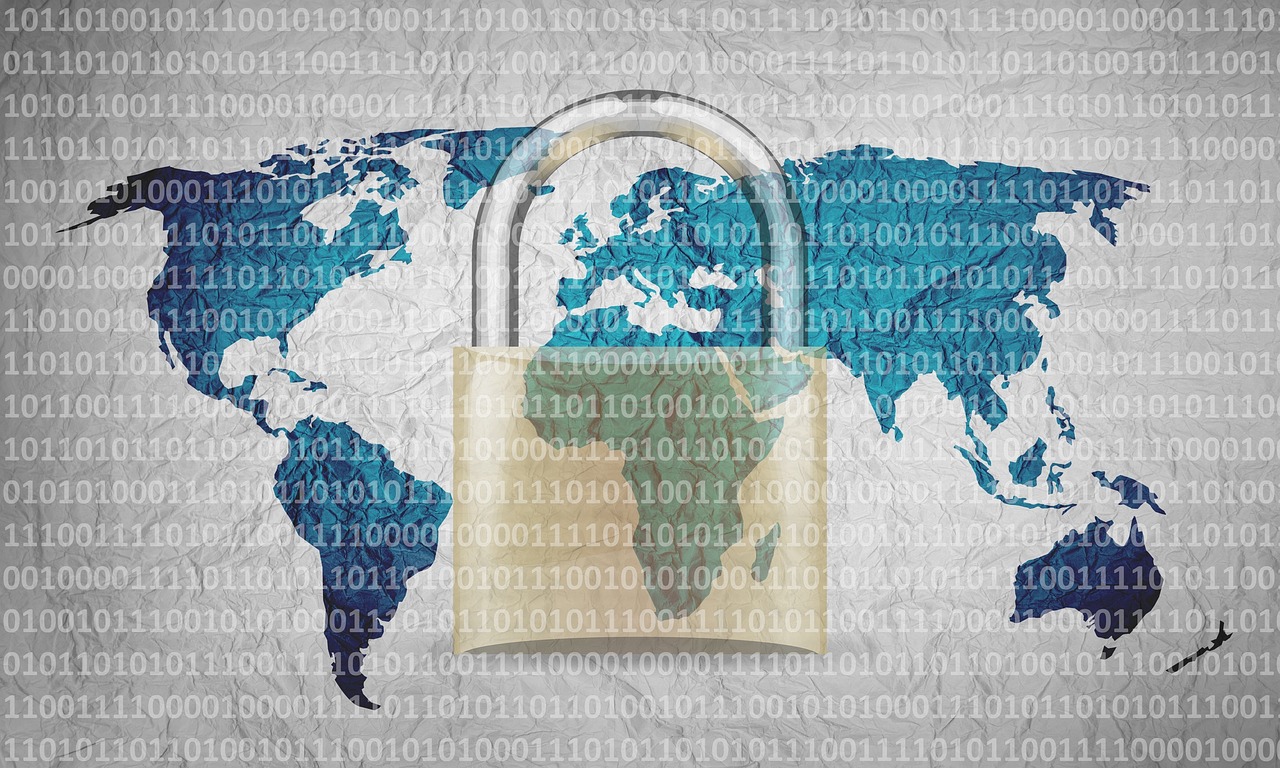
Notable Incidents
When we talk about state-sponsored cyber attacks, it's hard to ignore the significant incidents that have shaped the landscape of military cybersecurity. These attacks not only expose vulnerabilities but also illustrate the lengths to which adversaries will go to disrupt operations and compromise sensitive data. One of the most infamous incidents occurred in 2007 when Estonia faced a massive cyber assault that crippled its government and financial institutions. This attack, attributed to Russian hackers, highlighted the potential of cyber warfare to destabilize a nation without a single shot being fired.
Another pivotal moment came in 2010 with the emergence of the Stuxnet worm, which was specifically designed to target Iran's nuclear facilities. This sophisticated piece of malware not only showcased the capabilities of cyber weapons but also raised questions about the ethics of using such technology in warfare. The precision with which Stuxnet operated demonstrated that cyber attacks could achieve military objectives with minimal collateral damage, a concept that is both fascinating and frightening.
Moreover, the 2015 breach of the U.S. Office of Personnel Management (OPM) is a stark reminder of the vulnerabilities that exist even within the most secure military environments. This incident resulted in the theft of personal data from over 21 million individuals, including sensitive information related to security clearances. Such breaches can have long-lasting implications, affecting not just individuals but also national security as a whole.
To further illustrate the impact of these incidents, consider the following table that summarizes some notable cyber attacks against military operations:
| Incident | Year | Target | Attribution | Impact |
|---|---|---|---|---|
| Estonia Cyber Attack | 2007 | Government & Financial Institutions | Russia | Widespread disruption, national panic |
| Stuxnet Worm | 2010 | Iran's Nuclear Facilities | USA/Israel | Disruption of nuclear program |
| OPM Data Breach | 2015 | U.S. Government Personnel | China | Theft of sensitive personal data |
These incidents serve as a wake-up call for military operations worldwide. They underscore the need for robust cybersecurity measures that can adapt to evolving threats. As we delve deeper into the complexities of cyber warfare, it's crucial to learn from these past experiences to bolster our defenses and protect critical assets.
- What is a state-sponsored cyber attack? A state-sponsored cyber attack is a malicious attempt by a nation-state to infiltrate or disrupt another nation's systems, often targeting critical infrastructure, military operations, or sensitive data.
- How can military organizations improve their cybersecurity? Military organizations can enhance their cybersecurity by investing in advanced technologies, conducting regular training for personnel, and collaborating with private sector experts to stay ahead of potential threats.
- What role does training play in military cybersecurity? Training is vital as it equips military personnel with the knowledge and skills necessary to identify and respond to cyber threats effectively, fostering a culture of security within the organization.

Preventive Measures
In the ever-evolving landscape of cyber threats, implementing is not just a strategy; it’s a necessity for military operations. The stakes are incredibly high, and the consequences of a cyber breach can be devastating, ranging from the loss of sensitive data to compromising national security. Therefore, military organizations must adopt a multi-layered approach to cybersecurity that encompasses various strategies and technologies.
One of the primary preventive measures involves conducting regular risk assessments. By identifying potential vulnerabilities within their systems, military entities can prioritize their resources effectively and address the most critical weaknesses first. This proactive stance allows them to stay one step ahead of cyber adversaries. Additionally, integrating advanced encryption techniques can safeguard sensitive communications and data, making it significantly more challenging for unauthorized entities to intercept or exploit information.
Moreover, establishing a robust incident response plan is crucial. This plan should outline clear procedures for detecting, responding to, and recovering from cyber incidents. Regularly updating this plan ensures that military personnel are prepared for the latest threats and can act swiftly and decisively when a breach occurs. Simulations and drills play a vital role in this preparation, allowing teams to practice their response in a controlled environment, thereby enhancing their readiness for real-world scenarios.
Another critical aspect of preventive measures is fostering a culture of cybersecurity awareness within military ranks. Training programs tailored to different levels of personnel can help ensure that everyone understands their role in maintaining cybersecurity. This includes educating them about phishing attacks, social engineering tactics, and the importance of using secure passwords. By creating a knowledgeable workforce, the military can significantly reduce the risk of human error, which is often a weak link in cybersecurity.
Lastly, collaboration with the private sector can bring innovative solutions to the table. Many cybersecurity firms are at the forefront of technological advancements and can provide valuable insights into the latest tools and techniques. By sharing threat intelligence and best practices, military organizations can enhance their defensive capabilities and create a more resilient cybersecurity posture.
- What are the most common cyber threats faced by military operations?
Military operations face a variety of cyber threats, including state-sponsored attacks, ransomware, phishing scams, and insider threats. Each of these poses unique challenges that require tailored preventive measures. - How often should military organizations conduct risk assessments?
It is recommended that military organizations conduct risk assessments at least annually, or more frequently if there are significant changes in technology, personnel, or threat landscape. - What role does training play in military cybersecurity?
Training is essential for ensuring that all personnel understand the risks and best practices associated with cybersecurity. Regular training helps to create a culture of security and reduces the likelihood of human error. - How can collaboration with the private sector enhance military cybersecurity?
Collaboration with the private sector allows military organizations to leverage cutting-edge technologies, share threat intelligence, and adopt best practices that can significantly bolster their cybersecurity defenses.

Emerging Technologies in Cyber Defense
As we dive into the realm of cyber defense, it becomes abundantly clear that technology is not just a tool; it's a game changer. The military, tasked with safeguarding our nation's security, is increasingly turning to emerging technologies to bolster their defenses against relentless cyber threats. Imagine a battlefield where instead of tanks and soldiers, the weapons are algorithms and artificial intelligence. This shift is not just theoretical; it's happening right now, and it's reshaping how military operations are conducted.
One of the standout technologies making waves in military cybersecurity is artificial intelligence (AI). AI has the potential to analyze vast amounts of data at lightning speed, identifying patterns and anomalies that would take humans much longer to detect. This capability is crucial when you consider the sheer volume of data flowing through military networks. With AI, military cybersecurity teams can respond to threats in real-time, often before the threat even materializes. It's like having a crystal ball that predicts enemy movements—only this time, it's predicting cyber attacks.
Moreover, machine learning, a subset of AI, is proving to be invaluable. By continuously learning from past incidents, machine learning algorithms can improve their threat detection capabilities over time. This means that the more they are exposed to different types of attacks, the better they become at recognizing and neutralizing them. Think of it as training an elite soldier who gets smarter and more efficient with every mission.
Another fascinating technology is blockchain. While often associated with cryptocurrencies, blockchain's potential in military cybersecurity is immense. Its decentralized nature makes it exceptionally hard for cybercriminals to tamper with data. In military operations, where the integrity of information is paramount, blockchain can secure communications and ensure that data remains unaltered. Imagine a fortress where every brick is independently verified; that’s the kind of security blockchain offers.
Additionally, the rise of quantum computing is on the horizon. While still in its infancy, quantum computing could revolutionize encryption methods, making it virtually impossible for adversaries to crack codes. This technology promises not just to enhance security but to redefine what we consider secure communication. Picture a secret message that can only be read by the intended recipient—quantum computing is paving the way for such innovations.
However, with these advancements come challenges. The rapid pace of technological change means that military personnel must continually adapt and learn. Cybersecurity is not a set-it-and-forget-it scenario; it requires ongoing training and a proactive mindset. To that end, military organizations are investing in training programs that not only teach personnel how to use these new technologies but also instill a culture of security awareness across the board.
In conclusion, the emergence of these technologies is not just about keeping up with threats; it's about staying one step ahead. As military operations evolve, so too must the tactics and technologies employed to combat cyber threats. By embracing AI, machine learning, blockchain, and quantum computing, the military is not only enhancing its cybersecurity posture but also ensuring that it can effectively respond to the challenges of the future.
- What role does AI play in military cybersecurity? AI helps analyze large data sets quickly to identify and respond to threats in real-time.
- How does machine learning improve cybersecurity? Machine learning algorithms learn from past incidents, improving their ability to detect and neutralize threats over time.
- What is the significance of blockchain in military operations? Blockchain ensures data integrity and secures communications, making it difficult for cybercriminals to tamper with information.
- What potential does quantum computing hold for encryption? Quantum computing could revolutionize encryption methods, making secure communication nearly unbreakable.
- Why is ongoing training important in military cybersecurity? Continuous training helps personnel adapt to new technologies and fosters a culture of security awareness.

Training and Awareness Programs
In today's digital battlefield, have emerged as a cornerstone of military cybersecurity strategy. Just like a soldier must hone their physical skills, they also need to sharpen their mental acuity against the myriad of cyber threats that loom over military operations. The importance of these programs cannot be overstated, as they equip personnel with the knowledge and skills necessary to recognize and respond to cyber threats effectively.
Imagine a soldier preparing for combat without understanding the terrain or the enemy's tactics. In the same vein, military personnel must be well-versed in the complexities of cybersecurity. These training initiatives focus on a range of topics, from basic cybersecurity principles to advanced threat detection techniques. Regular training sessions ensure that all ranks, from new recruits to seasoned veterans, are on the same page regarding the latest cyber threats and defensive strategies.
One of the key components of these training programs is the emphasis on real-world scenarios. By simulating potential cyber incidents, military personnel can practice their responses in a controlled environment. This hands-on approach not only builds confidence but also enhances the effectiveness of the responses when faced with actual threats. For example, during a recent drill, soldiers were tasked with responding to a simulated ransomware attack on military systems. The exercise highlighted vulnerabilities and allowed teams to refine their incident response plans.
Moreover, the culture of security fostered through these programs plays a crucial role in the overall cybersecurity posture of military organizations. When personnel are aware of the risks and understand the importance of adhering to security protocols, they become the first line of defense against cyber threats. This culture is cultivated through ongoing education, workshops, and interactive sessions that encourage open dialogue about security practices.
Additionally, the integration of emerging technologies into training programs is revolutionizing how military personnel prepare for cyber threats. For instance, the use of virtual reality (VR) in training allows soldiers to immerse themselves in realistic cyber-attack scenarios, providing an unparalleled learning experience. This innovative approach not only makes training more engaging but also helps in retaining critical information.
To ensure that these programs remain effective and relevant, military organizations continuously assess and update their training materials. This adaptive approach allows them to stay ahead of evolving threats and incorporate the latest cybersecurity trends and technologies. As the cyber landscape changes, so too must the strategies employed to combat it.
In conclusion, training and awareness programs are not just an afterthought in military cybersecurity; they are a vital component of national defense. By investing in the education and preparedness of military personnel, organizations can significantly enhance their resilience against cyber threats. As the saying goes, "An ounce of prevention is worth a pound of cure," and this rings especially true in the realm of cybersecurity.
- What is the primary goal of training and awareness programs in military cybersecurity?
To equip military personnel with the knowledge and skills necessary to recognize and respond to cyber threats effectively. - How often are training programs conducted?
Training programs are conducted regularly, with updates to content reflecting the latest cyber threats and technologies. - What role does simulation play in training?
Simulations allow personnel to practice responses to cyber incidents, enhancing their readiness and effectiveness in real-world scenarios. - How does technology enhance training programs?
Emerging technologies like virtual reality provide immersive training experiences that improve engagement and knowledge retention.

Simulation and Drills
In the realm of military operations, the phrase "practice makes perfect" takes on a whole new meaning, especially when it comes to cybersecurity. As cyber threats become increasingly sophisticated, military organizations recognize that traditional training methods are no longer sufficient. This is where come into play. These exercises not only prepare personnel for real-life cyber incidents but also help to identify vulnerabilities in existing protocols and systems.
Imagine a high-stakes game of chess, where every move can either lead to victory or defeat. In the same way, cyber drills simulate the unpredictable nature of cyber warfare, allowing military teams to anticipate and respond to various attack scenarios. These simulations can range from simple tabletop exercises to complex, multi-agency drills that mimic real-world cyber incidents. The goal? To ensure that every team member knows their role and can act swiftly and decisively.
During these drills, military personnel engage in various scenarios, including phishing attacks, malware intrusions, and even full-scale network breaches. By facing these challenges in a controlled environment, they can hone their skills and improve their response times. For example, a recent drill conducted by the U.S. military involved a simulated attack on their logistics systems, testing both the technical response and the communication protocols among different units.
Moreover, the importance of realistic training cannot be overstated. The more lifelike the scenario, the better prepared the personnel will be. This is why many military organizations are investing in advanced technologies such as virtual reality (VR) and augmented reality (AR) to create immersive training experiences. These tools allow users to engage in realistic simulations that closely mimic actual cyber incidents, thereby enhancing their situational awareness and decision-making skills.
To illustrate the effectiveness of simulation and drills, consider the following table that outlines some key benefits:
| Benefits of Simulation and Drills | Description |
|---|---|
| Enhanced Readiness | Personnel become familiar with their roles and responsibilities during a cyber incident. |
| Improved Coordination | Drills foster teamwork and communication among different units and departments. |
| Identification of Weaknesses | Simulations reveal vulnerabilities in systems and protocols that can be addressed. |
| Increased Confidence | Regular practice boosts morale and confidence, enabling personnel to act decisively under pressure. |
Ultimately, simulation and drills are not just about practice; they are about creating a culture of preparedness within military organizations. By continuously engaging in these exercises, military personnel can stay ahead of the curve, adapting to new threats as they arise. As the saying goes, "An ounce of prevention is worth a pound of cure." In the context of cybersecurity, this means that the more prepared the military is for potential cyber threats, the better equipped they will be to defend against them.
- What are cyber drills? Cyber drills are simulated exercises that prepare military personnel for potential cyber incidents by practicing their response strategies.
- Why are simulations important? Simulations help identify vulnerabilities, improve coordination, and enhance readiness among military teams.
- How often should drills be conducted? Regular drills should be conducted to ensure that personnel remain familiar with procedures and can adapt to evolving threats.
- What technologies are used in simulations? Technologies such as virtual reality (VR) and augmented reality (AR) are increasingly used to create immersive training environments.

Collaboration with Private Sector
In today's rapidly evolving cyber landscape, the collaboration between the military and the private sector has never been more critical. As cyber threats become increasingly sophisticated, the military is recognizing the immense value that private companies bring to the table. These partnerships are not just beneficial; they are essential for developing robust cybersecurity frameworks that can effectively counteract emerging threats. Think of it as a powerful alliance, where the tactical expertise of the military meets the innovative technological advancements of the private sector.
Private companies, especially those specializing in cybersecurity, possess cutting-edge technologies and methodologies that can significantly enhance military operations. By working together, both sectors can share invaluable insights and best practices, creating a more resilient defense posture. For instance, private firms can provide advanced threat intelligence, which helps military personnel understand the latest tactics employed by cyber adversaries. This type of collaboration allows for a more proactive approach to cybersecurity, ensuring that defenses are not only reactive but also anticipatory.
Moreover, the private sector is often at the forefront of technological advancements, such as artificial intelligence and machine learning. These technologies can be game-changers in identifying and mitigating cyber threats. By integrating these innovations into military operations, the armed forces can achieve quicker detection and response times, effectively minimizing the impact of potential attacks. The synergy created through these collaborations can lead to the development of new tools and strategies that enhance the overall security framework.
One notable example of successful collaboration is the establishment of public-private partnerships (PPPs). These initiatives allow for the pooling of resources and expertise, fostering an environment where both parties can thrive. Through PPPs, the military can gain access to state-of-the-art cybersecurity solutions, while private companies can benefit from insights into the unique challenges faced by military operations. This reciprocal relationship not only strengthens national security but also drives innovation within the private sector.
Additionally, regular communication and information-sharing between military and private sector entities can lead to a more comprehensive understanding of the cyber threat landscape. By participating in joint exercises and simulations, both parties can practice their response to potential cyber incidents. This collaborative approach ensures that when a real threat arises, the military is not only prepared but also equipped with the latest strategies and technologies to address it effectively.
In conclusion, the collaboration between the military and the private sector is a vital component of modern cybersecurity strategies. By leveraging each other's strengths, both sectors can create a formidable defense against cyber threats. As we move forward, fostering these partnerships will be crucial in maintaining national security and safeguarding sensitive information from malicious actors.
- Why is collaboration with the private sector important for military cybersecurity? Collaboration allows the military to access innovative technologies and threat intelligence that enhance their cybersecurity capabilities.
- How can private companies contribute to military cybersecurity? Private companies can provide advanced tools, methodologies, and insights into the latest cyber threats, improving the military's defensive strategies.
- What are public-private partnerships (PPPs)? PPPs are initiatives that enable the military and private sector to pool resources and expertise to strengthen national security and drive innovation.
- How does regular communication benefit military and private sector collaboration? Regular communication fosters a better understanding of the cyber threat landscape, allowing both parties to prepare and respond effectively to potential incidents.

Future Trends in Military Cybersecurity
As we look ahead, the landscape of military cybersecurity is poised for significant transformation. The rapid pace of technological advancement means that the military must continuously adapt to new challenges and threats. One of the most exciting trends is the integration of artificial intelligence (AI) and machine learning (ML)
Another trend gaining momentum is the emphasis on collaborative defense strategies. The military is beginning to recognize the value of partnerships with technology firms and cybersecurity experts from the private sector. This collaboration allows for the exchange of threat intelligence and innovative solutions that can bolster defenses. By sharing information about vulnerabilities and attack vectors, military operations can stay one step ahead of potential adversaries. Think of it as a team of superheroes coming together to combat a common villain; each brings unique strengths to the table. Policy development is also a crucial aspect of the future of military cybersecurity. As cyber threats evolve, so too must the regulations and frameworks that govern military operations. This includes not only internal policies but also international cooperation agreements. Countries are beginning to realize that cyber warfare knows no borders, and a coordinated global response is essential. Just like in traditional warfare, alliances will play a vital role in enhancing collective security. The establishment of norms and rules for cyber engagements could reduce the likelihood of misunderstandings that might escalate into conflict. Furthermore, the focus on cyber hygiene is becoming an essential part of military training programs. Just as soldiers are trained in physical combat, they must also be equipped with knowledge about cybersecurity best practices. Future military personnel will undergo rigorous training to recognize phishing attempts, manage passwords securely, and understand the importance of maintaining software updates. This cultural shift towards cybersecurity awareness will be akin to teaching a soldier to check their gear before heading into battle; it’s about ensuring that every individual is a line of defense. Finally, the rise of quantum computing presents both opportunities and challenges for military cybersecurity. While quantum computing could revolutionize data processing and encryption, it also poses a threat to traditional encryption methods. As this technology matures, military cybersecurity strategies must evolve to incorporate quantum-resistant algorithms to safeguard sensitive information. The stakes are high, as the ability to protect data could mean the difference between national security and vulnerability. In conclusion, the future of military cybersecurity is not just about technology; it's about a holistic approach that incorporates training, policy, and international cooperation. As threats continue to evolve, so too must our strategies. The military must remain vigilant, adaptive, and proactive in its defense against the ever-changing landscape of cyber warfare. Cybersecurity is crucial in military operations because it protects sensitive information and ensures national security. With the rise of cyber threats, safeguarding data, communications, and infrastructure becomes vital for maintaining operational integrity and effectiveness. Military operations face a variety of cyber threats, including state-sponsored attacks, malware, phishing, and insider threats. Each of these can exploit vulnerabilities in military systems, potentially leading to severe consequences for national security. State-sponsored cyber attacks are typically more sophisticated and well-funded compared to other cyber threats. These attacks often target critical military infrastructure and sensitive data, making them particularly dangerous and challenging to defend against. Notable incidents include attacks on the U.S. Office of Personnel Management and the Iranian cyber attack on Saudi Aramco. These incidents highlight the tactics used by attackers and the potential implications for military operations and national security. Preventive measures include implementing advanced firewalls, conducting regular security audits, and maintaining updated software. Additionally, fostering a culture of cybersecurity awareness among personnel is essential for enhancing resilience against attacks. Emerging technologies like artificial intelligence and machine learning significantly enhance military cybersecurity by enabling faster detection and response to threats. These technologies help analyze vast amounts of data to identify potential vulnerabilities and attack patterns. Training and awareness programs are vital as they equip military personnel with the knowledge to recognize cybersecurity risks and implement best practices. This proactive approach fosters a culture of security, reducing the likelihood of successful cyber attacks. Simulations and drills are essential for practicing responses to cyber incidents. They help military personnel develop skills and strategies to effectively manage real-world cyber threats, enhancing overall readiness and operational effectiveness. Collaboration with the private sector allows the military to leverage innovative cybersecurity solutions and share threat intelligence. This partnership strengthens defense capabilities and fosters a more comprehensive approach to addressing cyber threats. Future trends in military cybersecurity may include advancements in technology, the development of new policies, and increased international cooperation. These trends will be essential for keeping pace with the evolving cyber threat landscape and ensuring robust defense mechanisms.
AI helps in analyzing data quickly, identifying potential threats, and automating responses to cyber incidents.
Collaboration allows the military to leverage innovative technologies and share vital threat intelligence, enhancing overall cybersecurity.
Cyber hygiene refers to practices and steps that users of computers and other devices take to maintain system health and improve online security.
Quantum computing can break traditional encryption methods, necessitating the development of new, quantum-resistant algorithms to protect sensitive information.Frequently Asked Questions

